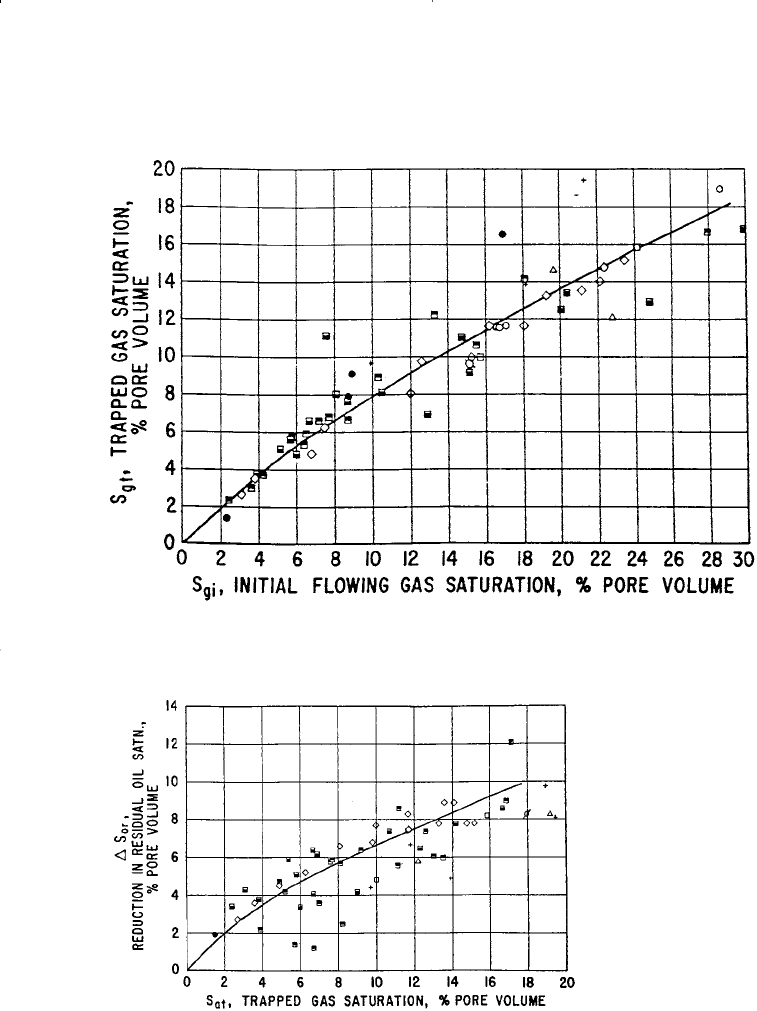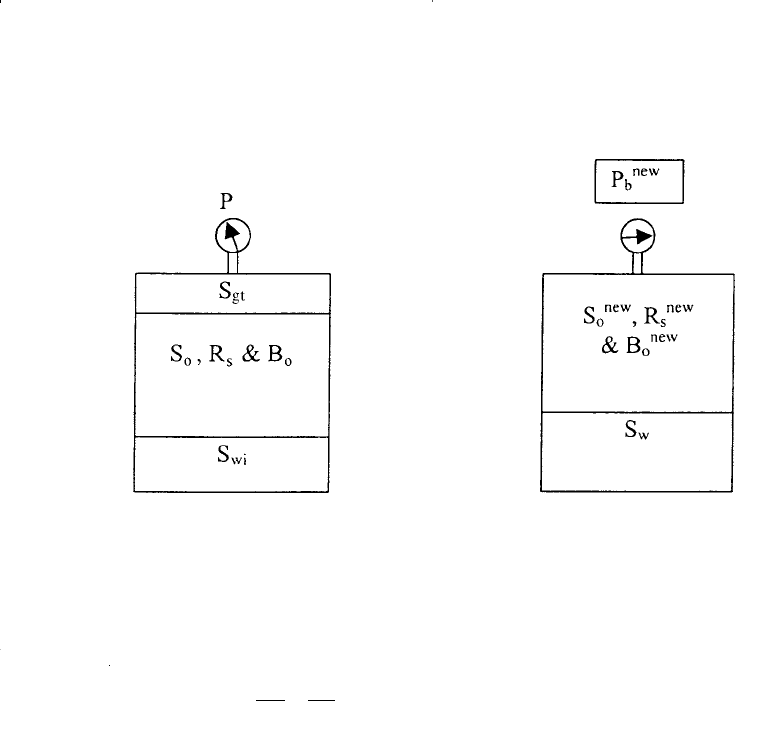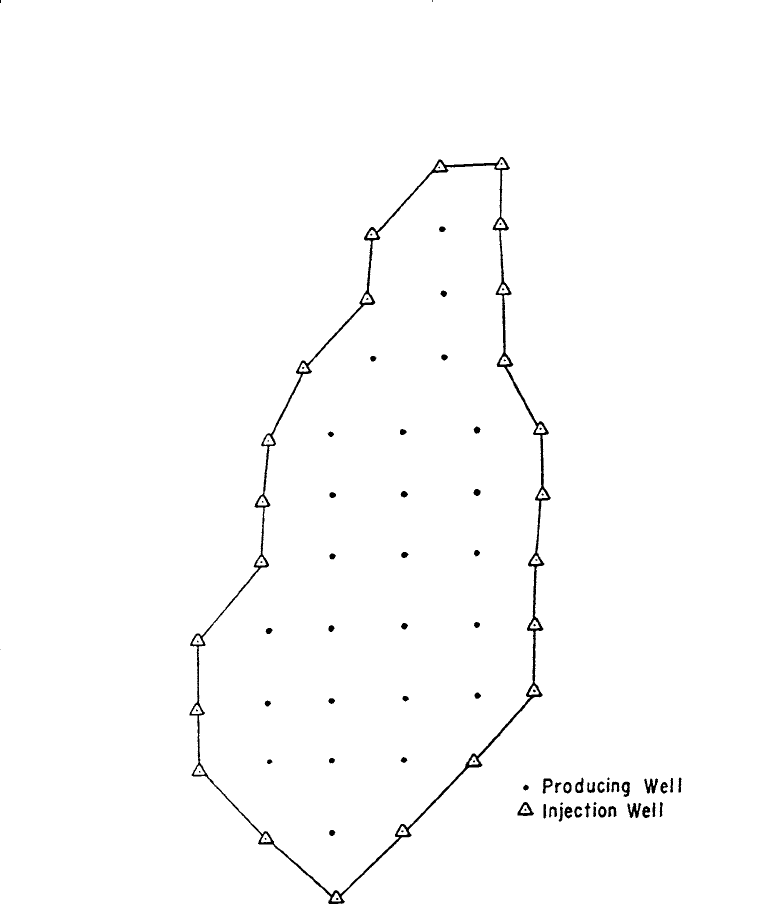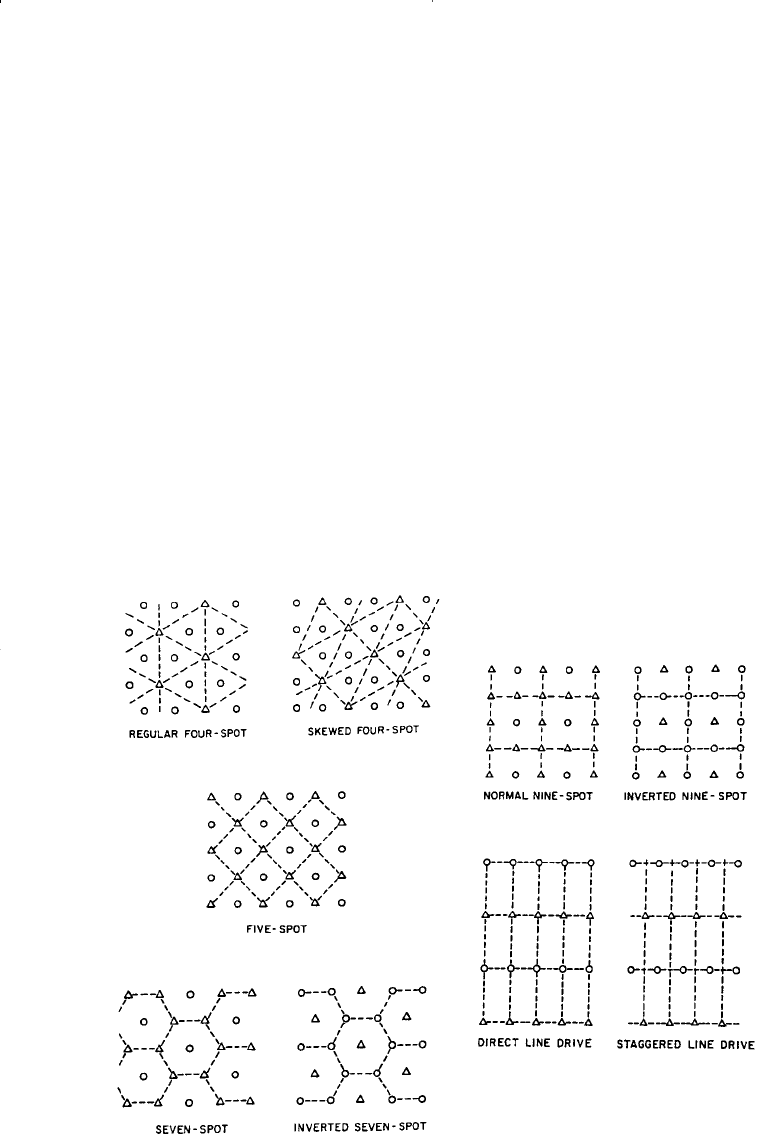Tarek Ahmed. Reservoir engineering handbook
Подождите немного. Документ загружается.


868 Reservoir Engineering Handbook
Figure 14-5. Relation between S
gi
and S
gt
. (Permission to publish by the Society of
Petroleum Engineers.)
Figure 14-6. Effect of S
gt
on waterflood recovery. (Permission to publish by the
Society of Petroleum Engineers.)
Reservoir Eng Hndbk Ch 14 2001-10-25 17:37 Page 868

illustrates the effect of the trapped gas saturation on the reduction in
residual oil saturation (S
or
) for preferentially water-wet rock. The two
graphic correlations can be expressed mathematically by the following
two expressions:
and
where S
gi
= initial gas saturation
S
gt
= trapped gas saturation
S
or
= reduction in residual oil saturation
Values of coefficients a
1
through a
5
for both expressions are tabulated below:
Coefficients Equation 14-1 Equation 14-2
a
1
0.030517211 0.026936065
a
2
0.4764700 0.41062853
a
3
0.69469046 0.29560322
a
4
–1.8994762 –1.4478797
a
5
–4.1603083 10
–4
–3.0564771 10
–4
Example 14-1
An oil reservoir is being considered for further development by initiat-
ing a waterflooding project. The oil–water relative permeability data
indicate that the residual oil saturation is 35%. It is projected that the ini-
tial gas saturation at the start of the flood is approximately 10%. Calcu-
late the anticipated reduction in residual oil, ∆S
or
, due to the presence of
the initial gas at the start of the flood.
Solution
Step 1. From Figure 14-5 or Equation 14-1, determine the trapped gas
saturation, to give:
S
gt
= 8%
∆SaaSaSaS
a
S
or gt gt gt
gt
=+ + + +
12 3
2
5
3
5
(14 - 2)
SaaSaSaS
a
S
gt gi gi gi
gi
=+ + + +
12 3
2
4
3
5
(14 -1)
Principles of Waterflooding 869
Reservoir Eng Hndbk Ch 14 2001-10-25 17:37 Page 869

Step 2. Estimate the reduction in the residual oil saturation from Figure
14-6 or Equation 14-2, to give:
S
or
= 5.7%
Therefore, new residual oil saturation is:
S
or
= 33%
Khelil (1983) suggests that waterflood recovery can possibly be
improved if a so-called “optimum gas saturation” is present at
the start of the flood. This optimum gas saturation is given by:
where (S
g
)
opt
= optimum gas saturation, fraction
S
o
, S
wi
= oil and initial water saturations, fraction
o
,
w
= oil and water viscosities, cp
k = absolute permeability, md
B
o
= oil formation volume factor, bbl/STB
φ = porosity, fraction
The above correlation is not explicit and must be used in conjunction
with the material balance equation (MBE). The proposed methodology
of determining (S
g
)
opt
is based on calculating the gas saturation as a func-
tion of reservoir pressure (or time) by using both the MBE and Equation
14-3. When the gas saturation as calculated by the two equations is iden-
tical, this gas saturation is identified as (S
g
)
opt
.
Example 14-2
An absolute permeability of 33 md, porosity of 25%, and an initial
water saturation of 30% characterize a saturated oil reservoir that exists
at its bubble-point pressure of 1925 psi. The water viscosity is treated as
a constant with a value of 0.6 cp. Results of the material balance calcula-
tions are given below:
()
.
..
..
.
S
kB
g opt
o
SS
o
o
wi
w
=
(
)
(
)
0 001867
0 634 0 902
0 352 0 166
1 152
µµ
φ
(14 - 3)
870 Reservoir Engineering Handbook
Reservoir Eng Hndbk Ch 14 2001-10-25 17:37 Page 870

Pressure, psi Bo, bbl/STB µ
o
, cp S
o
S
g
= 1 – S
o
– S
wi
1925 1.333 0.600 0.700 0.000
1760 1.287 0.625 0.628 0.072
1540 1.250 0.650 0.568 0.132
1342 1.221 0.700 0.527 0.173
Using the above data, calculate the optimum gas saturation.
Solution
Equation 14-3
Pressure, psi Bo, bbl/STB µ
o
, cp MBE, S
o
S
g
(S
g
)
opt
1925 1.333 0.600 0.700 0.000 —
1760 1.287 0.625 0.628 0.072 0.119
1540 1.250 0.650 0.568 0.132 0.122
1342 1.221 0.700 0.527 0.173
The calculated value of (S
g
)
opt
at 1540 psi agrees with the value of S
g
as
calculated from the MBE. Thus, to obtain the proposed additional recovery
benefit, the primary depletion should be terminated at a pressure of 1540 psi
and water injection initiated.
The injection into a solution gas-drive reservoir usually occurs at injection
rates that cause repressurization of the reservoir. If pressure is high enough,
the trapped gas will dissolve in the oil with no effect on subsequent residual
oil saturations. It is of interest to estimate what pressure increases would be
required in order to dissolve the trapped gas in the oil system. The pressure is
essentially defined as the “new” bubble-point pressure (P
b
new
). As the pres-
sure increases to the new bubble-point pressure, the trapped gas will dissolve
in the oil phase with a subsequent increase in the gas solubility from R
s
to
R
s
new
. As illustrated in Figure 14-7, the new gas solubility can be estimated as
the sum of the volumes of the dissolved gas and the trapped gas in the reser-
voir divided by the volume of stock-tank oil in the reservoir, or:
R
S
B
R
S
B
S
B
S
new
O
o
S
gt
g
o
o
=
(
)
(
)
+
(
)
(
)
(
)
(
)
Pore volume
Pore volume
Pore volume
Principles of Waterflooding 871
Reservoir Eng Hndbk Ch 14 2001-10-25 17:37 Page 871

Simplifying gives:
where R
s
new
= gas solubility at the “new” bubble-point pressure,
scf/STB
R
s
= gas solubility at current pressure p, scf/STB
B
g
= gas formation volume factor, bbl/scf
B
o
= oil formation volume factor, bbl/STB
S
gt
= trapped gas saturation
The pressure that corresponds to the new gas solubility (R
s
new
) on the
R
s
vs. p relationship is then identified as the pressure at which the
trapped gas will completely dissolve in the oil phase.
RR
S
S
B
S
new
S
gt
o
o
g
=+
B
(14 - 4)
872 Reservoir Engineering Handbook
Figure 14-7. Variable bubble-point pressures.
Reservoir Eng Hndbk Ch 14 2001-10-25 17:37 Page 872

Example 14-3
The Big Butte Field is a solution gas-drive reservoir that is under con-
sideration for a waterflood project. The volumetric calculations of the
field indicate that the areal extent of the field is 1612.6 acres. The field is
characterized by the following properties:
Thickness h = 25 ft
Porosity = 15%
Initial water saturation S
wi
= 20%
Initial pressure p
i
= 2377 psi
Results from the MBE in terms of cumulative oil production N
p
as a
function of reservoir pressure p are given below:
Pressure, psi N
p
, MMSTB
2377 0
2250 1.10
1950 1.76
1650 2.64
1350 3.3
The PVT properties of the crude oil system are tabulated below:
Pressure, psi B
o
, bbl/STB R
s
, scf/STB B
g
, bbl/scf
2377 1.706 921 —
2250 1.678 872 0.00139
1950 1.555 761 0.00162
1650 1.501 657 0.00194
1350 1.448 561 0.00240
1050 1.395 467 0.00314
750 1.336 375 0.00448
450 1.279 274 0.00754
Assume that the waterflood will commence when the reservoir pres-
sure declines to 1650 psi; find the pressure that is required to dissolve the
trapped gas.
Principles of Waterflooding 873
Reservoir Eng Hndbk Ch 14 2001-10-25 17:37 Page 873

Solution
Step 1. Calculate initial oil in place N:
N = 7758 A h φ (1 – S
wi
)/B
oi
N = 7758 (1612.6) (25) (0.15) (1 – 0.2)/1.706 = 22 MMSTB
Step 2. Calculate remaining oil saturation by applying Equation 12-5 at
1650 psi:
Step 3. Calculate gas saturation at 1650 psi:
S
g
= 1 – S
o
– S
wi
S
g
= 1 – 0.619 – 0.2 = 0.181
Step 4. Calculate the trapped gas saturation from Figure 14-5 or Equa-
tion 14-1, to give:
S
gt
= 12.6%
Step 5. Calculate the gas solubility when all the trapped gas is dissolved
in the oil by applying Equation 14-4:
Step 6. Enter the tabulated PVT data with the new gas solubility of
814 scf/STB and find the corresponding pressure of approximately
2140 psi. This pressure is identified as the pressure that is
required to dissolve the trapped gas.
Rsc
S
new
=+
=657
0 126
0 619
1 501
0 00194
814
.
.
.
.
f/STB
SS
N
N
B
B
S
owi
p
o
oi
o
=−
(
)
−
=−
(
)
−
=
11
1021
264
22
1 501
1 706
0 619.
.
.
.
.
874 Reservoir Engineering Handbook
Reservoir Eng Hndbk Ch 14 2001-10-25 17:37 Page 874

SELECTION OF FLOODING PATTERNS
One of the first steps in designing a waterflooding project is flood
pattern selection. The objective is to select the proper pattern that will
provide the injection fluid with the maximum possible contact with the
crude oil system. This selection can be achieved by (1) converting
existing production wells into injectors or (2) drilling infill injection
wells. When making the selection, the following factors must be
considered:
• Reservoir heterogeneity and directional permeability
• Direction of formation fractures
• Availability of the injection fluid (gas or water)
• Desired and anticipated flood life
• Maximum oil recovery
• Well spacing, productivity, and injectivity
In general, the selection of a suitable flooding pattern for the reservoir
depends on the number and location of existing wells. In some cases,
producing wells can be converted to injection wells while in other
cases it may be necessary or desirable to drill new injection wells.
Essentially four types of well arrangements are used in fluid injection
projects:
• Irregular injection patterns
• Peripheral injection patterns
• Regular injection patterns
• Crestal and basal injection patterns
Irregular Injection Patterns
Willhite (1986) points out that surface or subsurface topology and/or
the use of slant-hole drilling techniques may result in production or
injection wells that are not uniformly located. In these situations, the
region affected by the injection well could be different for every injection
well. Some small reservoirs are developed for primary production with a
limited number of wells and when the economics are marginal, perhaps
only few production wells are converted into injectors in a nonuniform
pattern. Faulting and localized variations in porosity or permeability may
also lead to irregular patterns.
Principles of Waterflooding 875
Reservoir Eng Hndbk Ch 14 2001-10-25 17:37 Page 875

Peripheral Injection Patterns
In peripheral flooding, the injection wells are located at the external bound-
ary of the reservoir and the oil is displaced toward the interior of the reservoir,
as shown in Figure 14-8. Craig (1971), in an excellent review of the peripher-
al flood, points out the following main characteristics of the flood:
876 Reservoir Engineering Handbook
Figure 14-8. Typical peripheral waterflood. (After Cole, F., 1969.)
Reservoir Eng Hndbk Ch 14 2001-10-25 17:37 Page 876

• The peripheral flood generally yields a maximum oil recovery with a
minimum of produced water.
• The production of significant quantities of water can be delayed until
only the last row of producers remains.
• Because of the unusually small number of injectors compared with the
number of producers, it takes a long time for the injected water to fill up
the reservoir gas space. The result is a delay in the field response to the
flood.
• For a successful peripheral flood, the formation permeability must be
large enough to permit the movement of the injected water at the
desired rate over the distance of several well spacings from injection
wells to the last line of producers.
• To keep injection wells as close as possible to the waterflood front
without bypassing any movable oil, watered-out producers may be
Principles of Waterflooding 877
Figure 14-9. Flood patterns. (Permission to publish by the Society of Petroleum
Engineers.)
Reservoir Eng Hndbk Ch 14 2001-10-25 17:37 Page 877
